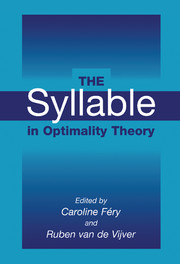Book contents
- Frontmatter
- Contents
- List of Contributors
- Preface
- The Syllable in Optimality Theory
- Part One INTRODUCTION
- Part Two SYLLABLE STRUCTURE AND PROSODIC STRUCTURE
- 2 Sympathy, Cumulativity, and the Duke-of-York Gambit
- 3 The Controversy over Geminates and Syllable Weight
- 4 The Syllable as a Unit of Prosodic Organization in Japanese
- 5 Prosodic Weight
- Part Three NONMORAIC SYLLABLES AND SYLLABLE EDGES
- Part Four SEGMENTS AND SYLLABLES
- Part Five HOW CONCRETE IS PHONOTACTICS?
- Author Index
- Languages Index
- Subject Index
4 - The Syllable as a Unit of Prosodic Organization in Japanese
Published online by Cambridge University Press: 03 July 2009
- Frontmatter
- Contents
- List of Contributors
- Preface
- The Syllable in Optimality Theory
- Part One INTRODUCTION
- Part Two SYLLABLE STRUCTURE AND PROSODIC STRUCTURE
- 2 Sympathy, Cumulativity, and the Duke-of-York Gambit
- 3 The Controversy over Geminates and Syllable Weight
- 4 The Syllable as a Unit of Prosodic Organization in Japanese
- 5 Prosodic Weight
- Part Three NONMORAIC SYLLABLES AND SYLLABLE EDGES
- Part Four SEGMENTS AND SYLLABLES
- Part Five HOW CONCRETE IS PHONOTACTICS?
- Author Index
- Languages Index
- Subject Index
Summary
Introduction
The traditional typology proposed by Trubetzkoy (1969) classifies Tokyo Japanese as a typical “mora language” as opposed to a “syllable language.” The conception of the mora as an indispensable unit in Japanese can be supported by a wide range of linguistic evidence (see Kubozono 1999 for a summary). In comparison, it is not very clear yet what role the syllable plays in the same prosodic system, particularly in the nonderivational framework of Optimality Theory (OT – Prince and Smolensky 1993).
The goal of this chapter is twofold. First, I will show that several independent phenomena in Japanese exhibit the dominance of heavy-light over light-heavy structures. These phenomena include motherese (mother–baby language), emphatic mimetics, and sporadic lengthenings and shortenings, which all have drawn little or no attention in the literature, as well as the now well-known phenomena of loanword truncation and zuzya-go (jazz musicians' language). Moreover, it is argued that similar asymmetries occur in longer words involving three or more feet, such as compound nouns and the chanting phrases used in baseball cheering. By demonstrating the magnitude with which such a prosodic asymmetry occurs, I will argue for a syllable-based generalization of Japanese and, hence, for the universality of the syllable as an organizing element of phonological structure. Second, I will present an optimality-theoretic analysis of the phenomena exhibiting the asymmetries in syllabic organization.
- Type
- Chapter
- Information
- The Syllable in Optimality Theory , pp. 99 - 122Publisher: Cambridge University PressPrint publication year: 2003
- 15
- Cited by



